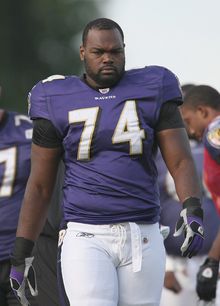 |
| Michael Oher |
If you have not seen the film “Blind Side,” do yourself a favor and buy a copy of the DVD for your collection. We watched “Blind Side” again this weekend. It is a heart warming feel-good family story. The great thing about Blind Side is it is a true story. The bad thing about the film is that near the end of it we are given valuable insight into the self-righteous NCAA and the potential for catastrophic consequences as a result of its so-called policing efforts. Blind Side teaches us many important lessons. One of those lessons is that the NCAA is an organization without a soul, because the NCAA might well have destroyed all the good that came to the life of Michael Oher if it had its way. Fortunately for Michael Oher, there was just too much family love involved for the hypocrisy of the NCAA to kill.
 In the sports news over the weekend it was reported that several
In the sports news over the weekend it was reported that several
 |
| Terrelle Pryor |
Yes, scholarships are handed out to players. And yes, there is some opportunity for competition on the playing field. But make no mistake. There is no industry in America
 In all other sports where money flows freely, leagues impose reasonable roster count limits. In the NFL, the roster limit is about fifty players. The NCAA allows major university football programs to use their insidious competitive advantages to hoard eight-five players, far more than they need. The result of this rule is that good players ride the benches at big schools while smaller schools never have a chance to compete for those athletes. Whereas the NFL structures a draft system to maintain the delicacies of competitive balance, the NCAA institutionalizes a system that insures just the opposite. While the NFL takes it upon itself to assure competitive scheduling, the NCAA allows four or five dozen so-called “major” conference programs to systematically avoid scheduling games with up and coming so-called mid-majors like Boise State or TCU.
In all other sports where money flows freely, leagues impose reasonable roster count limits. In the NFL, the roster limit is about fifty players. The NCAA allows major university football programs to use their insidious competitive advantages to hoard eight-five players, far more than they need. The result of this rule is that good players ride the benches at big schools while smaller schools never have a chance to compete for those athletes. Whereas the NFL structures a draft system to maintain the delicacies of competitive balance, the NCAA institutionalizes a system that insures just the opposite. While the NFL takes it upon itself to assure competitive scheduling, the NCAA allows four or five dozen so-called “major” conference programs to systematically avoid scheduling games with up and coming so-called mid-majors like Boise State or TCU. There are more charades on the way. Right after the NCAA executives and the major conference universities cash their BCS bowl appearance checks and successfully block efforts to create a fair playoff system, they will look into the punishments doled out to those horrible Ohio State Buckeye players. After all, they cannot look the other way and allow greed and corruption to rule. Can they?
There are more charades on the way. Right after the NCAA executives and the major conference universities cash their BCS bowl appearance checks and successfully block efforts to create a fair playoff system, they will look into the punishments doled out to those horrible Ohio State Buckeye players. After all, they cannot look the other way and allow greed and corruption to rule. Can they?
